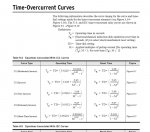mbrooke
Batteries Included
- Location
- United States
- Occupation
- Technician
I think you need have actual fault conditions to know exact pick up values. Have you got those data to work out exact pick up values?
I'd rather know ahead of time- and that is the point. You need to know what you are telling the relay to do as the desired response is known and often must be within very tight tolerances.


